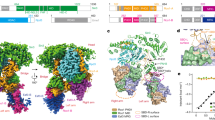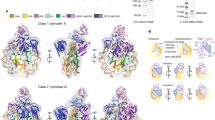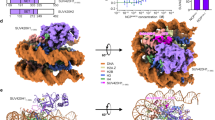Abstract
Nucleosomes are decorated with numerous post-translational modifications capable of influencing many DNA processes1. Here we describe a new class of histone modification, methylation of glutamine, occurring on yeast histone H2A at position 105 (Q105) and human H2A at Q104. We identify Nop1 as the methyltransferase in yeast and demonstrate that fibrillarin is the orthologue enzyme in human cells. Glutamine methylation of H2A is restricted to the nucleolus. Global analysis in yeast, using an H2AQ105me-specific antibody, shows that this modification is exclusively enriched over the 35S ribosomal DNA transcriptional unit. We show that the Q105 residue is part of the binding site for the histone chaperone FACT (facilitator of chromatin transcription) complex2. Methylation of Q105 or its substitution to alanine disrupts binding to FACT in vitro. A yeast strain mutated at Q105 shows reduced histone incorporation and increased transcription at the ribosomal DNA locus. These features are phenocopied by mutations in FACT complex components. Together these data identify glutamine methylation of H2A as the first histone epigenetic mark dedicated to a specific RNA polymerase and define its function as a regulator of FACT interaction with nucleosomes.
This is a preview of subscription content, access via your institution
Access options
Subscribe to this journal
Receive 51 print issues and online access
$199.00 per year
only $3.90 per issue
Buy this article
- Purchase on Springer Link
- Instant access to full article PDF
Prices may be subject to local taxes which are calculated during checkout




Similar content being viewed by others
Accession codes
Accessions
ArrayExpress
Data deposits
Data of the ChIP-seq experiments have been deposited in Array Express under accession number E-MTAB-1447.
References
Kouzarides, T. Chromatin modifications and their function. Cell 128, 693–705 (2007)
Formosa, T. The role of FACT in making and breaking nucleosomes. Biochim. Biophys. Acta 1819, 247–255 (2012)
Polevoda, B. & Sherman, F. Methylation of proteins involved in translation. Mol. Microbiol. 65, 590–606 (2007)
Petrossian, T. C. & Clarke, S. G. Multiple motif scanning to identify methyltransferases from the yeast proteome. Mol. Cell. Proteomics 8, 1516–1526 (2009)
Tollervey, D., Lehtonen, H., Jansen, R., Kern, H. & Hurt, E. C. Temperature-sensitive mutations demonstrate roles for yeast fibrillarin in pre-rRNA processing, pre-rRNA methylation, and ribosome assembly. Cell 72, 443–457 (1993)
Gautier, T., Bergès, T., Tollervey, D. & Hurt, E. Nucleolar KKE/D repeat proteins Nop56p and Nop58p interact with Nop1p and are required for ribosome biogenesis. Mol. Cell. Biol. 17, 7088–7098 (1997)
Fath, S. et al. Association of yeast RNA polymerase I with a nucleolar substructure active in rRNA synthesis and processing. J. Cell Biol. 149, 575–590 (2000)
Krogan, N. J. et al. Global landscape of protein complexes in the yeast Saccharomyces cerevisiae. Nature 440, 637–643 (2006)
Lambert, J.-P., Mitchell, L., Rudner, A., Baetz, K. & Figeys, D. A novel proteomics approach for the discovery of chromatin-associated protein networks. Mol. Cell. Proteomics 8, 870–882 (2009)
Jansen, R. P. et al. Evolutionary conservation of the human nucleolar protein fibrillarin and its functional expression in yeast. J. Cell Biol. 113, 715–729 (1991)
Amin, M. A. et al. Fibrillarin, a nucleolar protein, is required for normal nuclear morphology and cellular growth in HeLa cells. Biochem. Biophys. Res. Commun. 360, 320–326 (2007)
Raška, I., Shaw, P. J. & Cmarko, D. Structure and function of the nucleolus in the spotlight. Curr. Opin. Cell Biol. 18, 325–334 (2006)
Albert, B., Perez-Fernandez, J., Léger-Silvestre, I. & Gadal, O. Regulation of ribosomal RNA production by RNA polymerase I: does elongation come first? Genet. Res. Int. 2012, 276948 (2012)
Grummt, I. & Längst, G. Epigenetic control of RNA polymerase I transcription in mammalian cells. Biochim. Biophys. Acta 1829, 393–404 (2013)
Ide, S., Miyazaki, T., Maki, H. & Kobayashi, T. Abundance of ribosomal RNA gene copies maintains genome integrity. Science 327, 693–696 (2010)
Gorenstein, C., Atkinson, K. D. & Falkes, E. V. Isolation and characterization of an actinomycin D-sensitive mutant of Saccharomyces cerevisiae. J. Bacteriol. 136, 142–147 (1978)
VanDemark, A. P. et al. Structural and functional analysis of the Spt16p N-terminal domain reveals overlapping roles of yFACT subunits. J. Biol. Chem. 283, 5058–5068 (2008)
McCullough, L. et al. Insight into the mechanism of nucleosome reorganization from histone mutants that suppress defects in the FACT histone chaperone. Genetics 188, 835–846 (2011)
Smith, J. S. & Boeke, J. D. An unusual form of transcriptional silencing in yeast ribosomal DNA. Genes Dev. 11, 241–254 (1997)
Johnson, J. M. et al. Rpd3 and Spt16-mediated nucleosome assembly and transcriptional regulation on yeast rDNA genes. Mol. Cell. Biol. 33, 2748–2759 (2013)
Hainer, S. J., Pruneski, J. A., Mitchell, R. D., Monteverde, R. M. & Martens, J. A. Intergenic transcription causes repression by directing nucleosome assembly. Genes Dev. 25, 29–40 (2011)
Orphanides, G., Wu, W. H., Lane, W. S., Hampsey, M. & Reinberg, D. The chromatin-specific transcription elongation factor FACT comprises human SPT16 and SSRP1 proteins. Nature 400, 284–288 (1999)
Birch, J. L. et al. FACT facilitates chromatin transcription by RNA polymerases I and III. EMBO J. 28, 854–865 (2009)
Belotserkovskaya, R. et al. FACT facilitates transcription-dependent nucleosome alteration. Science 301, 1090–1093 (2003)
Winkler, D. D., Muthurajan, U. M., Hieb, A. R. & Luger, K. Histone chaperone FACT coordinates nucleosome interaction through multiple synergistic binding events. J. Biol. Chem. 286, 41883–41892 (2011)
Formosa, T. et al. Defects in SPT16 or POB3 (yFACT) in Saccharomyces cerevisiae cause dependence on the Hir/Hpc pathway: polymerase passage may degrade chromatin structure. Genetics 162, 1557–1571 (2002)
Wittner, M. et al. Establishment and maintenance of alternative chromatin states at a multicopy gene locus. Cell 145, 543–554 (2011)
Choudhary, C. et al. Lysine acetylation targets protein complexes and co-regulates major cellular functions. Science 325, 834–840 (2009)
Wang, B., Malik, R., Nigg, E. A. & Körner, R. Evaluation of the low-specificity protease elastase for large-scale phosphoproteome analysis. Anal. Chem. 80, 9526–9533 (2008)
Santos-Rosa, H. et al. Methylation of histone H3 K4 mediates association of the Isw1p ATPase with chromatin. Mol. Cell 12, 1325–1332 (2003)
Janke, C. et al. A versatile toolbox for PCR-based tagging of yeast genes: new fluorescent proteins, more markers and promoter substitution cassettes. Yeast 21, 947–962 (2004)
Longtine, M. S. et al. Additional modules for versatile and economical PCR-based gene deletion and modification in Saccharomyces cerevisiae. Yeast 14, 953–961 (1998)
Patrone, G. et al. Nuclear run-on assay using biotin labeling, magnetic bead capture and analysis by fluorescence-based RT-PCR. BioTechniques 29, 1012–1014,. 1016–1017 (2000)
Li, H. & Durbin, R. Fast and accurate short read alignment with Burrows-Wheeler transform. Bioinformatics 25, 1754–1760 (2009)
Li, H. et al. The Sequence Alignment/Map format and SAMtools. Bioinformatics 25, 2078–2079 (2009)
Quinlan, A. R. & Hall, I. M. BEDTools: a flexible suite of utilities for comparing genomic features. Bioinformatics 26, 841–842 (2010)
Bartke, T. et al. Nucleosome-interacting proteins regulated by DNA and histone methylation. Cell 143, 470–484 (2010)
Shevchenko, A., Wilm, M., Vorm, O. & Mann, M. Mass spectrometric sequencing of proteins silver-stained polyacrylamide gels. Anal. Chem. 68, 850–858 (1996)
Nielsen, M. L. et al. Iodoacetamide-induced artifact mimics ubiquitination in mass spectrometry. Nature Methods 5, 459–460 (2008)
Rappsilber, J., Ishihama, Y. & Mann, M. Stop and go extraction tips for matrix-assisted laser desorption/ionization, nanoelectrospray, and LC/MS sample pretreatment in proteomics. Anal. Chem. 75, 663–670 (2003)
Cox, J. & Mann, M. MaxQuant enables high peptide identification rates, individualized p.p.b.-range mass accuracies and proteome-wide protein quantification. Nature Biotechnol. 26, 1367–1372 (2008)
Cox, J. et al. Andromeda: a peptide search engine integrated into the MaxQuant environment. J. Proteome Res. 10, 1794–1805 (2011)
Cox, J. et al. A practical guide to the MaxQuant computational platform for SILAC-based quantitative proteomics. Nature Protocols 4, 698–705 (2009)
Acknowledgements
We thank E. Hurt, D. Stillman, T. Kobayashi, J. Smith and J. Boeke for providing strains; K. Lilley for mass spectrometry and M. Vermeulen for help with identifying H2AQ104me; S. Moss for running the Illumina MiSeq; members of the Kouzarides laboratory for discussions; and A. Bannister and R. Belotserkovskaya for reading the manuscript. This work has been financed by a programme grant from Cancer Research UK and a project grant from the Biotechnology and Biological Sciences Research Council (BB/K017438/1).
Author information
Authors and Affiliations
Contributions
P.T. and H.S.-R. designed experiments, performed research, interpreted data and wrote the manuscript. K.B.S. and M.L.N. performed mass spectrometry. C.J.N. supplied new reagents. T.K. designed experiments, interpreted data and wrote the manuscript.
Corresponding author
Ethics declarations
Competing interests
T.K. is a founder of Abcam Ltd.
Extended data figures and tables
Extended Data Figure 1 Mass spectrometry of histone H2A.
a, Tandem mass spectrum of the unmodified peptide sequence VTIAQGGVLPNIQAVLLPK from histone H2A. The spectrum correlates with the Q104me modified spectrum presented in Fig. 1a. b, Isotope cluster of Q104me modified peptide VTIAQGGVLPNIQAVLLPK from H2A. Using high-resolution mass spectrometry ensures that peptides are identified with an accuracy of parts per million.
Extended Data Figure 2 Position of H2AQ105 in the nucleosome.
Structure of the yeast nucleosome (1ID3). Q105 is highlighted as a red sphere, localized at the surface of the histone octamer without contacting the DNA, but it is part of the interface between H2A and H3. H3 is in yellow, H4 in orange, H2A in blue and H2B in green.
Extended Data Figure 3 Quality control of the H2A Q105me antibody.
a, Examples of dot blots of dilution series (1:2) of unmodified or methylated peptide spotted on 0.22 μm PVDF membrane and developed using the anti-H2A Q105me antibody. b, Left, western blot on lysates of cells harbouring either WT or Q105A H2A as sole source of histones; right, human lysate from MCF10A cells. All western blots were probed with the anti-H2AQ105me-specific antibody or anti-H2A upon stripping, respectively. c, Peptide competition by western blotting with the indicated peptides shows that only the methylated peptide can compete the signal of MCF10A lysates (peptide concentration was at 1 μg ml−1). d, Direct enzyme-linked immunosorbent assay (ELISA) against the indicated peptides. Biotinylated peptides were immobilized on streptavidine-coated 96-well plates and the ELISA was performed using a 1:20,000 dilution of the anti-Q105me antibody. The ELISA was developed using horseradish peroxidase (HRP)-coupled secondary anti-rabbit antibody and 3,3′, 5,5′′-tetramethylbenzidine (TMB) as substrate.
Extended Data Figure 4 Western blot quantification of in vitro methylation reaction and detailed fragmentation table.
a, Quantification of five independent in vitro methylation reactions. Western blots were scanned and intensities were determined using ImageJ. *P < 0.05. b, Theoretical and measured b- and y-ion fragment masses for Q104 methylation of human H2A (peptide sequence VTIAQGGVLPNIQAVLLPK) for mass spectrum shown in Fig. 2e.
Extended Data Figure 5 Western blot quantification and growth curves for Nop1/fibrillarin depletion.
a, Quantification of western blots for Fig. 2f. Here, the average band intensities of three independent experiments were determined using ImageJ and plotted. The amounts of H2AQ105me were expressed as relative levels at time point t = 0. *P < 0.05. b, Growth curve of WT and nop1.3 ts strains upon shift to restrictive temperature. c, Alignment of yeast Nop1 and its mammalian orthologue fibrillarin indicates that both proteins share around 70% identity. d, Human fibrillarin is able to replace yeast Nop1 to methylate H2AQ105 in vivo. Note that human fibrillarin migrates slightly faster than yeast Nop1. e, Quantification of western blots for Fig. 2g. Here, the average band intensities of three independent experiments were determined using ImageJ and plotted. *P < 0.05. f, MTT assays of MCF10A cells transfected with scrambled RNA interference or RNA interference directed against fibrillarin (si5 and si6).
Extended Data Figure 6 Deletion of rDNA copies does not affect H2AQ105me.
The deletion of rDNA copies in yeast (as indicated in the figure) does not decrease the level of Q105me within the cells. Extracts from yeast isogenic yeast strains harbouring different numbers of rDNA repeats were subjected to western blotting and probed with the anti-Q105me and anti-H2A antibodies respectively.
Extended Data Figure 7 Actinomycin D treatment leads to loss of Q104/5me in cells.
a, Logarithmically growing yeast cells were treated with 500 ng ml−1 actinomycin D (ActD+) or dimethylsulphoxide (ActD−) for 2 h before fixation. ChIP against Q105me and H2A was analysed with the indicated primer sets and the ratio treated/untreated (showing either an increase or decrease in treated/untreated samples) was plotted in log2 scale. b, MCF10A cells were treated with either dimethylsulphoxide or 50 ng ml−1 actinomycin D for 2 h specifically to shut down RNA polymerase-I-mediated transcription. Cells were fixed and processed for immunofluorescence with the indicated antibodies/dyes. c, As in b, but with NIH-3T3 cells.
Extended Data Figure 8 Genetic interaction of spt16-11 and H2AQ105A.
a, Sequence of H2A with highlighted residues that genetically interact positively (light blue,17 or negatively (green)18 with FACT thermosensitive mutations. H2AQ105 (red) is part of this region. b, Analysis of wild-type H2A or H2AQ105A in either wild type (SPT16) or thermosensitive mutations (spt16-11) with respect to their effect on the induction of a FACT-dependent gene (GAL1). Cells were grown in Raffinose-containing media overnight, diluted into Raffinose-containing media and allowed to grow to mid-logarithmic phase before shifting them to restrictive temperature for 4 h. Gal1 was induced by addition of 2% galactose (final). Samples were taken before and 120 min after induction. The relative ratio of GAL1-mRNA levels of three independent experiments is given. Also note that this assay is artificial as Q105me is not detected at the GAL1 locus in wild-type strains and is only intended to show a potential genetic interaction between H2AQ105me and FACT if they occur at a given genomic location. It is important to note that GAL1 is an inducible gene and different functions of FACT are required for inducible and steadily expressed genes. The activation of promoters requires the removal of nucleosomes whereas constitutive transcription relies on both removal and re-deposition. To understand the differences between these two FACT functions, we looked at the steady-state level of (c) low, (d) mid- and (e) high constitutively expressed genes at 30 °C. Interestingly, in contrast to inducible genes, many constitutive genes show increased transcription in Q105A and spt16, in agreement with a more open chromatin state.
Extended Data Figure 9 FACT binds to a region spanning H2AQ105.
a, Left, the peptides enriched in a phage display screen using recombinant Spt16/Pob3 as bait; right, a putative consensus binding sequence (red). b, The interaction between Q105 and FACT and the influence of its methylation are conserved from yeast to mammalian cells. HeLa nuclear extract was incubated with the indicated peptides bound to streptavidin-coupled Dynabeads. Bound proteins were analysed by western blotting.
Extended Data Figure 10 Influence of H2AQ105A on Nap1 binding.
a, The induction kinetics for Gal1-driven H2A in wild-type and spt16 mutant cells, as well as H2AQ105A, is identical. Cells were treated as in Fig. 4f and samples were taken at the indicated time points and analysed by western blotting. b, H2A Q105 is not required for interaction with the histone chaperone Nap1. Flag-tagged Nap1 was used to immunoprecipitate either wild-type H2A or the Q105A mutant H2A. An untagged wild-type strain served as background control.
Supplementary information
Supplementary Tables
This file contains Supplementary Tables 1-3. (PDF 147 kb)
Supplementary Data
This file contains Supplementary Table 4, which shows proteins identified in active fraction using LC-MS/MS. H2A-interacting proteins are marked in orange and (putative) methylatransferases in yellow. (XLS 64 kb)
Rights and permissions
About this article
Cite this article
Tessarz, P., Santos-Rosa, H., Robson, S. et al. Glutamine methylation in histone H2A is an RNA-polymerase-I-dedicated modification. Nature 505, 564–568 (2014). https://doi.org/10.1038/nature12819
Received:
Accepted:
Published:
Issue Date:
DOI: https://doi.org/10.1038/nature12819
This article is cited by
-
STAT3 potentiates RNA polymerase I-directed transcription and tumor growth by activating RPA34 expression
British Journal of Cancer (2023)
-
Nucleolar reorganization after cellular stress is orchestrated by SMN shuttling between nuclear compartments
Nature Communications (2023)
-
Current research on viral proteins that interact with fibrillarin
Molecular Biology Reports (2023)
-
Atypical chemokine receptor 3 induces colorectal tumorigenesis in mice by promoting β-arrestin-NOLC1-fibrillarin-dependent rRNA biogenesis
Acta Pharmacologica Sinica (2022)
-
Selective translation of epigenetic modifiers affects the temporal pattern and differentiation of neural stem cells
Nature Communications (2022)
Comments
By submitting a comment you agree to abide by our Terms and Community Guidelines. If you find something abusive or that does not comply with our terms or guidelines please flag it as inappropriate.



